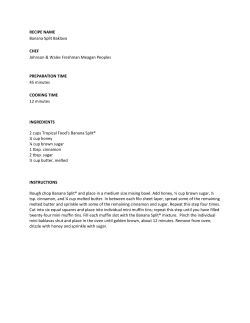
MFA CATALOGUE
2015 MFA CATALOGUE this catalogue was produced on the occasion of the 2015 MFA EXHIBITION EXHIBITION Location: TKM Gråmølna Trenerys gate 9 7042 Trondheim Coordinators: Prof. David Rych, Prof. Milica Tomic CATALOGUE Instructor / Supervisor: Prof. Regina (Maria) Möller Trondheim Academy of Fine Art - KiT Faculty of Architecture and Fine Art Norwegian University of Science and Technology - NTNU www.kit.ntnu.no ISBN: 978-82-92788-12-7 Print Run: 200 Printer: NTNU Grafisk Senter, Trondheim © 2015 — Eva Margrethe Ballo, Dayna Desireé Bartoli Carlos Alberto Correia, Amalia Marie Fonfara Saman Haghighivand, Inger Margrethe Hove Laustsen Regina (Maria) Möller, Karianne Ommundsen France Rose, David Rych CONTENT Preface: Regina (Maria) Möller Acknowledgments Ingredients for Thought: David Rych Eva Margrethe Ballo Dayna Desireé Bartoli Carlos Alberto Correia Amalia Marie Fonfara Saman Haghighivand Inger Margrethe Hove Laustsen Karianne Ommundsen France Rose INGREDIENTS FOR THOUGHT David Rych Spirit incorporates history by assimilating, by remembering its own past. This assimilation acts as a kind of sublimated eating — spirit eats everything that is external and foreign, and thereby transforms it into something internal, something that is its own. Everything shall be incorporated into the great digestive system — nothing is inedible in Hegel’s infinite metabolism.1 In general a student graduation show hardly ever follows the established logic of a contemporary art exhibition, where artists and their respective works have been chosen and aligned according to an overarching curatorial concept. Having said that, a conceptual theme that encompasses all positions on display in the first graduation exhibition of the international master program of the Academy of Fine Art in Trondheim, which this publication is accompanying, has indeed emerged from within the master student groups’ ability to share and reflect over a common denominator, which in this case has been immanently the role of self-prepared meals for their gatherings. The show at TKM Gråmølna integrates the notion of food in listing the ingredients of elaborate dishes, according to recipes, which can be found on the following pages of this catalogue. Food and art have kept a lasting relation throughout history, while it was above all in the 20th century that the art of cooking was equally integrated in the repertoire of vanguard practices. One may possibly think of the Futurists’ “culinary revolution” declared by Marinetti in an “Anti-Pasta Manifesto”, which signified the Futurists’ attempt to revolutionize the way how we eat and at the same time how we perceive art, in order to ultimately change society as a whole. Blinding out the Futurist´s obsession with progress and their misguided political affiliation, what I want to emphasize on in this very context is their understanding that food and its preparation was considered a key element to the constitution of society. A quite different, more convivial approach in this field surfaced again many decades later in the late 1990’s with individual artistic approaches, which experienced social interaction with an audience over food to be generally recognized as a valid art practice and known under the term Relational Aesthetics, as coined by Nicolas Bourriaud. The preparation of food, which will take place during events in the frame of the MFA exhibition, is at the same time gesture and cultural commentary, which in a similar way reflects the idea that creative experience is elicited from within and empowered by everyday life. Rather than to break away with traditions, we encounter a recreation of consensual reciprocity – an attempt to situate the individual in a setting that makes aware through a ritual that nourishes a sense of belonging, regardless of all differences, which in contrast food is often an embodiment of. After all, cuisine has always been a direct way to enter different cultures. In her essay “Food as an Emerging Diplomatic Tool in Contemporary Public Art” Carly Schmitt elaborates on art projects, which take food as a platform for conducting cultural diplomacy and a foundation for intercultural exchange, as “to encourage a conversation about larger more challenging topics.” Apart from the fertile social momentum, a talk over food instantly creates, the act of ingesting organic material has frequently been paralleled with taking in knowledge by thinkers from Montaigne to Derrida, who have compared the very notion of comprehending to incorporation (and ultimately digestion). In a Deleuzian-Guattarian sense a prepared dish could be considered an assemblage, very much in the same sense as this book containing these recipes and artists’ contributions would. And I dare to say that all artistic positions in this exhibition, which in itself symbolizes an assemblage, are ingredients that make up a complex recipe, once seen in relation to each other. The MFA exhibition is anchored in a number of phenomenological tropes, materializing as installations, single channel work and still photography as well as sculptural elements. The installative ensembles of Carlos Alberto Correia depart from a common conception of the natural sublime by investigating the tripartite axiom between the existent in an ontological sense, its conceptual definition and representation. To him naming and defining by thought and assumption exemplifies a man made logic of attribution, which is in tension with a more speculative understanding of the real, a system of thought, which he visually transfers onto materials like felt and aluminium in combination with a realtime video feed of Gullfoss, a waterfall in Iceland. In her object arrangements, Dayna Desireé Bartoli can be seen as carrying on with a correlated premise, in creating pseudo-scientific classifications to make sense out of obscure material traces. Her displays turn plant life, found fabrics and childhood photographs into artefacts, of which some again enter an additional level in photographic depiction, drawing on the concept of preservation as a temporal illusion. Perception, reality and imagination are a red thread in the exhibition, which leads on from observation to speculation. Amalia Marie Fonfara embarks on a visual journey to investigate the crossings of inner and outer worlds through introspection and experimentation with spiritual practices based on shamanism and other cross-cultural spiritual practices, where the essences of soul and materiality are entangled in a holistic comprehension of all life. Phenomenological sensations and associative reverberations of other artists’ work, poetic contemplation on colour nuances and wanderlust weave the fabric of Eva Margrethe Ballo’s multifaceted installation works. Among other things, we find a tent in white cotton as a “ghost” of a travel she had earlier made, which assumes the function of a basic observatory to study the changes of light and time. A more ephemeral medium of the artist can be found in letter conversations with other authors, which enfold in philosophical debates about celestial phenomena with a sentiment of longing and a sense of wit. Driven by a fascination with the traces of everyday life, Inger Margrethe Hove Laustsen turns through her work to the deeper narratives that rest within the profane world of objects. Personal reminiscences tie into a semi-ficticious take on travel and memory, which articulate in symbolic forms and arrangements. Here it is the route of posted letters that pass through many hands in exchange and finally charged with the aura of many stories, amass in the shape of a backpack. Travel, which also carries the weight of departure from the perspective of someone leaving memories behind, is the psychological realm that Saman Haghighivand repeatedly enters in his elaborate film works. Amnesia is a film about the inability of humans to surpass a traumatic experience coupled to guilt and shame. The artist’s use of puppets allows for an unusual scenario, which evolves into an uncanny reflection on the conditions of human existence. A very different traumatic rupture on a larger collective scale resonates in the video work of Karianne Ommundsen. The aftermath of the attack on the government quarter in Oslo on the 22nd of July 2011 and the moods of the public discourse around it are inscribed in the aging concrete matter of an architecture, which is soon to belong to the past. The video work seems to be searching for evidence in the endless pebbles of the walls, which the camera relentlessly tracks down to pure abstraction, as a way to avoid naming the unspeakable by transcending the visual surface of what is left. The double projection Conversations with Myselves places France Rose in a binary setting with himself in the opposite sex. Also here it is the biased world of definition and categorisation, in this case as applied to gender norms, which is contested in the form of an explicit dialogue. The idea of sexual dualism, which in a hetero-normative environment is taken as a given fact, is hereby deconstructed and complicated to raise awareness about limiting concepts of self-definition. Composed from a multitude of heterogeneous elements that enter into relations with one another, the artistic formations on display in the MFA show create the social fabric of an assemblage, which precisely in this growth in dimension into communality change in nature as they expand their connections. Beyond the murmurs of a current “Zeitgeist”, this idiographic mapping of experience, reflection and abstraction found in the works in the exhibition allows us to consider new intriguing perspectives of a yet to be digested comprehension of the reality we share – and internalize it, like a bite of food. 1 Daniel Birnbaum and Anders Olsson, An Interview with Jacques Derrida on the Limits of Digestion. This conversation took place on October 25, 1990. The text was originally published in the Swedish newspaper Expressen (February 15, 1991) and e-flux journal #2 (01/2009) Eva Margrethe Ballo Eva Margrethe Ballo was born in 1988. She received a Bachelors degree in textile from Kunstfag at The Academy of Fine Art in Oslo, 2013, and a Master of Fine Arts degree from the Trondheim Academy of Fine Art at the Norwegian University of Science and Technology (KiT / NTNU) in Norway, 2015. Many of her works involve painting on fabric, where she makes images of the mysterious. Ballo collects materials that have for her an aesthetic that tells a story through associations and the material properties. Her working process is intuitive and starts rather simple, for example with a feeling, a place, a text, a colour, a shape, or a picture. ev-ballo@online.no +47 95856847 10 onions Butter Olive oil Salt Pepper Sugar Sherry Bay Leaves Thyme Chicken Stock Soy sauce Bread and cheese Soup Remove the dry skin from the onions. Part the onion in four pieces. Save the skin for the dyeing later. Cut the onion pieces in thin slices. Put the slices in a big warm pot together with butter and olive oil. Add salt. Wait with the sugar, it might be sweet enough on its own. Let them cook as slow and long as possible. Pour in the sherry and let it simmer down. Take bay leaves and thyme and chicken stock and add it to the soup. Let it cook for an hour. Season and taste while cooking, add water if it gets too thick and maybe some soy sauce at the end. Serve the soup with bread and cheese. Dye Have the onion skins in a pot with water and let them boil for some hours to extract the pigment from the peel. Do not separate the peel from the water right away; let it rest overnight. When dyeing, to get an even result, soak the fabric in water first. Heat the pigment, add the fabric, let it boil for an hour. With a stick or something pointy, remove the air, bubbling up under the fabric. To make the color last, let it lay for a day or two, or longer, but not until it rots. chef: Eva Margrethe Ballo date: April 19, 2015 location: Skybar, KiT DYED ONION SOUP Dayna Desireé Bartoli Dayna Desireé Bartoli is an artist from Arizona who works in various mediums including photography, bookmaking, and mixed media objects. Many of Bartoli’s projects are driven by a fascination with natural phenomena and the language of medical and scientific representation. She graduated from Arizona State University in 2010 with a Bachelor of Fine Arts in photography. In 2015 she received a Master of Fine Arts degree from the Trondheim Academy of Fine Art at the Faculty of Architecture and Fine Art, Norwegian University of Science and Technology (KiT / NTNU) in Norway. Bartoli’s photographs were published in the Julty 2013 issue of Harper’s Magazine. Lens Culture online photography magazine named her one of “21 New and Emerging Photographers” of 2013, and she has been a featured artist in the online directory of noted photographers, Art Photo Index. www.daynabartoli.com dayna.bartoli@gmail.com Makes 8 servings 7 cups of water 1 ½ cups of sugar 1 ½ cups of freshly squeezed lemon juice 6-7 sprigs of your choice of herb (good choices are: thyme, rosemary, or basil) lemon slices, for garnish To make the herb infused simple syrup: Add the sugar, herbs, and 1 ½ cups of water to a saucepan. Stir until sugar is dissolved over medium heat. Let the syrup cool down a bit. To mix the lemonade: Add the simple syrup, fresh lemon juice, and 4 cups of water to a pitcher. Stir, and add more water to adjust to your taste if necessary. Pour over ice with fresh herbs and lemon slices for garnish. To make it a cocktail, add in a shot of your favorite liquor. Whiskey, vodka, or tequila is recommended bartender: Dayna Desireé Bartoli date: May. 22, 2015 location: Skybar, KiT HERB INFUSED LEMONADE Carlos Alberto Correia Carlos Alberto Correia was born in Portugal, in 1989. Correia completed a Bachelor in Painting at the Faculty of Fine Arts at the University of Lisbon in 2011. He also did the first year of a Master in Aesthetics at the Faculty of Social and Human Sciences of the New University of Lisbon (Universidade NOVA de Lisboa). He received his MFA from the Trondheim Academy of Fine Art, Faculty of Architecture and Fine Art at the Norwegian University of Science and Technology (KiT/NTNU) in 2015. He has had solo shows in Módulo Gallery in Lisbon and in the Municipal Archive of Photography in Lisbon, and noted group shows at Módulo Gallery and Gallery Rafael Ortiz. Correia is represented by Módulo Gallery in Lisbon and his work is in the collections of Carmona e Costa Foundation and the Municipal Archive of Photography in Lisbon. www.carlosalbertocorreia.com correia.caf@gmail.com 1 lemon peel 1 tbsp of butter 1 cinnamon stick 1 pinch of salt 125g of rice 150g of sugar 750ml of milk 3 egg yolks cinnamon for sprinkling Boil water in a pot with salt. When it is boiled add the rice and cook it for 2 minutes. Meanwhile boil the milk with the cinnamon stick and the lemon peel. Drain the rice well and soak it in the boiled milk. Let it cook, uncovered, over low heat. Remove the rice from the heat and add the sugar, stirring quickly. Add the egg yolks and the butter. Cook the rice for a few more minutes, very mild without boiling. Pour into bowls or serving plates and sprinkle with cinnamon powder. chef: Carlos Alberto Correia date: Dec. 8, 2014 location: Intermedia, KiT SWEET RICE Amalia Marie Fonfara Amalia Marie Fonfara is a Danish artist. She was born in Greenland in 1985 but she has lived most of her life in Denmark. Fonfara was educated at the Trondheim Academy of Fine Art, Faculty of Architecture and Fine Art at the Norwegian University of Science and Technology (KiT / NTNU). She graduated with a Bachelor of Fine Art in 2013, and in 2015 with a Master of Fine Art. In her artistic practice Fonfara is interested in the esoteric. Her work seeks to investigate borders between spirituality and the imagined. Her work bridges the fields of visual art, neo-shamanism, theosophy, anthropology, healing, and New Age-spirituality. From a cosmological point of view, she investigates the inner landscape and the border between our conscious life; what we experience in meditation, dreams and trance. Fonfara works with a variety of medias such as sculpture, performance, photo, text-based works and video installations. Her works create a subtle, sensitive and intimate atmosphere. She currently lives and works in Trondheim. amalia.fonfara@gmail.com 2 ripe bananas 100 g sugar 1 teaspoon vanilla sugar 1 egg 4 tablespoon milk 50 g melted butter 125 g flour 1 teaspoon baking powder Mash the bananas and stir them with sugar, vanilla sugar and egg. Sieve flour and baking powder and stir it in. Fill the dough in a greased rim form. Baking time: moderate heat (170ºC/340°F) for about 30 minutes chef: Amalia Marie Fonfara date: May 14 , 2015 location: Regina’s professor studio, KiT BANANA CAKE Saman Haghighivand Saman Haghighivand was born in Iran in 1988. He received a Bachelors degree in 2012 in cinema / film-direction from Art University of Tehran, and a Master of Fine Arts degree from the Trondheim Academy of Fine Art, Faculty of Architecture and Fine Art at the Norwegian University of Science and Technology (KiT/NTNU) in Trondheim, Norway in 2015. Haghighivand is a film / video artist and a musician. He has been working on subjects regarding refugees since he started studying in Norway. Amnesia, alienation, integration and traumas are the most highlighted topics of his works. In his short film titled “Amnesia”, he began experimenting with using puppets as actors. Working with puppets allowed him to address topics in a different, yet subtle way and to reflect a new on image production in films and videos. His films have been screened in several festivals including the 2013 Noor Film Festival in Los Angeles California, 2012 Tehran International Short Film Festival, 2011 and 2009 Nahal Film Festivals in Tehran, 2011 Montreal Asian Film Festival, and the 2009 Bubblegum Film Festival in Dublin. saman.haghighivand@gmail.com +47 45181225 +98 9125450801 300 g grilled aubergine 3 medium to large tomatoes 3 tablespoons frying oil 6 cloves garlic, minced 2 eggs Sea salt freshly ground black pepper 1-2 tablespoons extra-virgin olive oil Preheat the oven to 175°C/350°F. Pour the frying oil on a baking sheet. Add minced garlic to the oil. Stop cooking before the garlic gets brown (after you are able to smell the baked garlic). Lay the grilled aubergine on the baking sheet and let it bake for 20 minutes (until the aubergine is medium fried). Add the minced tomato over top of the aubergine to completely cover it. Then add pepper and mix it. Wait until the red liquid of tomato dissolves in the aubergine, which takes around 15 minutes. Decrease the heat to 50°C/120°F. Add the beaten eggs and salt to the aubergine and mix them. Wait around five minutes until the eggs are fully cooked. Transfer to a serving bowl. Serve warm topped with the extra-virgin olive oil. chef: Saman Haghighivand date: May. 14, 2014 location: Regina’s professor studio, KiT MIRZAGHASEMI Inger Margrethe Hove Laustsen Inger Margrethe Hove Laustsen was born in Thy, Denmark in 1986. She was educated at the Trondheim Academy of Fine Art, Faculty of Architecture and Fine Art at the Norwegian University of Science and Technology (KiT/NTNU) in Trondheim, Norway, where she graduated with a Bachelor of Fine Art in 2013 and a Master of Fine Art in 2015. In 2011/2012 she did a semester of exchange study at the Department for Fine Art at Konstfack University College of Arts, Crafts and Design in Stockholm, Sweden. Laustsen’s artistic practice revolves around a fascination with everyday life, objects, furniture and interior design – particularly, she investigates their traces and memories to reveal or revive their complex and multifaceted stories. Her projects are rather detailed and discreet, and are sometimes on the border to the invisible. Working with various materials and media, ranging from everyday objects, photography, printed matter, text, and design - she clearly positions her practice on the interfaces between art, crafts and design to not only blur the boundaries between these professions, but to offer multiple readings. An integral part of her artistic practice is to work in collaborations, which she did throughout her studies at KIT / NTNU. She currently lives and works in Trondheim, Norway and Copenhagen, Denmark. www.ingerhove.dk inger.m.h.laustsen@gmail.com Applesauce: Apples (if you have Filippa apples in your garden, they are perfect for this autumn/winter dessert) A little bit of cane sugar A vanilla pod A tiny bit of apple juice or water Optional: A few cinnamon sticks or a few slices of fresh ginger or ecological lemon peel Granola: Oatmeal or muesli A bit of cane sugar Cinnamon Optional: Almonds, pumpkin seeds, sesame seeds, or other types of nuts or seeds. Topping: Whipped cream, crème fraîche, Greek yoghurt, or vanilla ice cream. Applesauce Peel the apples, remove the cores, and divide them into eighths. Put the apples pieces in a pot with a tiny bit of apple juice or water (just enough to cover the bottom of the pot so the apple pieces do not get burned). Add sugar after taste; some prefer the applesauce sweet, others prefer it a bit sour. Divide the vanilla pod in two and scratch the inside of it out with a knife. Add the vanilla seeds to the pod. If you like cinnamon, ginger, or lemon, you can add a few cinnamon sticks or a few slices of fresh ginger or ecological lemon peel. Let everything boil shortly at a high temperature. Afterwards, you turn down the heat. Let the mass boil at a low temperature until the apples are mashed and the majority of the moisture has evaporated. The applesauce should have a firm consistency. Let the applesauce cool off prior to serving. Granola Add oatmeal or muesli to a pan with a bit of cane sugar and heat it all at a low temperature in order not to burn the sugar. Add cinnamon, chopped almonds, pumpkin seeds, or other types of nuts or seeds if you like. The granola is finished when it starts to get colour. Let the granola cool off on a plate prior to serving. Serving You can make a bigger collective portion or smaller individual portions. Begin with a layer of applesauce followed by a layer of granola. You can add as many layers as you wish. Top the final layer with whipped cream. You may decorate the whipped cream with chopped almonds or a bit of the granola and a sprinkle of cinnamon for aesthetic reasons. You can also serve the apple cake with crème fraîche, Greek yoghurt, or vanilla ice cream instead of whipped cream. chefs: Inger M. H. Laustsen & Carlos A. Correia date: Sep. 24, 2014 location: Intermedia, KiT APPLE CAKE Karianne Ommundsen Karianne Ommundsen was born in Stavanger in 1986, and is educated as an artist and art historian with Master degrees from the Department of Humanities and Trondheim Academy of Fine Art at the Norwegian University of Science and Technology (KiT / NTNU). In 2014 Ommundsen initiated a reading and discussion forum at the Trondheim Academy of Fine Art called “Critical Salon”. Her artistic practice revolves around topics such as trauma, memory, and history. She has experimented with different mediums, and is currently working mainly with film and video. www.karianneommundsen.com karianneommundsen@gmail.com +47 91144062 2 spoons olive oil 1 yellow onion 3 cloves garlic 1,5 fresh chilli 3 scallions 1 teaspoon turmeric 1,5 teaspoon cumin 0,5 tsp. cinnamon 0,5 tsp. black pepper 0,5 tsp. nutmeg 0,5 tsp. cardamom 0,5 tsp. coriander 0,5 tsp. cloves 1 can tomatoes 3 dl coconut milk 2 dl red lentils 3 dl water 1 lime fresh coriander salt bread or/and rice Pour olive oil in a spacious pot, and heat it. Add chopped onion, garlic and chili. Make sure the onion is sautéed. Put in chunks of scallions. Add the different spices. Pour tomatoes, water and coconut milk into the mixture. Add more water if you want the soup thinner. Simmer in 15-20 minutes. Season with salt and lime. Garnish with thin slices of scallions and coriander. Serve the soup alone or with rice/bread. chef: Karianne Ommundsen date: Dec. 8, 2014 location: Intermedia, KiT SPICY VEGAN LENTIL SOUP France Rose France Rose is a New Orleans-born, Norway-residing academic, artist and activist in the realm of queer rights. Previously he studied for an MPhil in Sociology from University of Cape Town with a focus on gender and sexuality, and now he applies the acquired theory to his artistic practice. He currently explores how contemporary art can be a platform for addressing gender norms, particularly in its capacity to expose and deconstruct normative. Rose received an MFA from the Trondheim Academy of Fine Art, Facutly of Architecture and Fine Art at the Norwegian University of Science and Technology (KiT/NTNU) in 2015. He plans to continue working as an artist and activist, and, if the stars align, do a doctorate in something interesting so that he can one day teach in Universities. www.artgenderart.com france.rose.hartline@gmail.com +47 45181902 1 cup butter, softened 3/4 cup granulated sugar 3/4 cup packed light brown sugar 1 tsp. vanilla extract 2 eggs, or egg substitutes 2-1/4 cups white flour (add an extra ¼-½ cup for thicker, drier cookies) 1 tsp. baking soda 1/2 tsp. salt 2 cups. chopped chocolate bars (mix of dark and milk) optional: add 1 ½ tsp. instant coffee Heat oven to 190°C/375°F. Beat butter, granulated sugar, brown sugar and vanilla in large bowl with mixer until creamy. Add eggs; beat well. Add in instant coffee, if desired. Stir together flour, baking soda and salt; gradually add to butter mixture, beating until well blended. Stir in chocolate chunks, if desired. Drop by teaspoons onto ungreased cookie sheet. Bake 8 to 10 minutes or until lightly browned. Cool slightly; remove from cookie sheet to wire rack. Cool completely. Makes about 5 dozen cookies. Feed to people you love. Unless they’re burnt, in which case just pretend you never made any. chef: France Rose date: Dec. 12, 2013 location: France’s Studio, KiT TRADITIONAL CHOCOLATE CHIP COOKIES
© Copyright 2025










